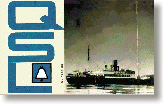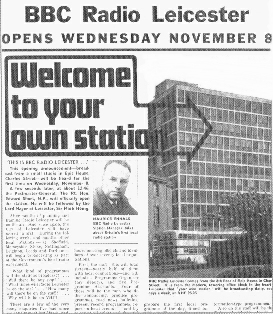Sixties Radio

|
Sixties Radio |

|
|
|
|
Instead, it stuck to the tried and tested formula of a mixture of soaps, comedy programmes, quiz shows and light or classical music. Its output consisted of three main 'channels' comprising of the Home Service ( which was Radio 4 style ), the Third Programme and Network 3 ( Radio 3 style ) and the Light Programme ( Radio 2 style ). The first two entertained the middle-aged
middle and upper-class audiences with various types of programme, none
of which particularly appealed to the new youth culture. The B.B.C. did make a couple of minor concessions to the new music culture with a programme on Saturday mornings called ' The Saturday Skiffle Club' ( later to drop the 'Skiffle' ) and a review of the singles record chart on Sunday afternoons. |
|

|
Even in this, the shows were hosted by presenters, like Don Moss, who were more used to the usual B.B.C. output, making the end result rather uninspired. Things improved slightly in 1961 when Alan 'Fluff' Freeman took over Sunday's 'Pick Of The Pops' slot from the more sedate David Jacobs (left) but his upbeat style was not particularly to the taste of the corporation management and he was not infrequently requested to 'tone it down'. The following year saw another programme called 'Teenager's Turn - Here We Go' on which The Beatles made their radio debut in March 1962. |
|
|
There were few alternatives, the best of which was probably in frequenting one of the multitude of small coffee bars with the obligatory jukebox that sprang up ever faster around this time although they were not a new phenomenon. Other than that there were the 'listening booths' at your local record shop or, if you happened to live near the east coast, you could try tuning your wireless to Radio Luxembourg which was coming in from across the North Sea on 208 metres medium wave. The only snag being that the signal fluctuated a lot and it could only be received between about 7p.m. and 3a.m. Shows which could frequently be heard were a Merseybeat feature called 'Saturday Night at The Cavern' and a programme called 'Swingtime' which went out on Sundays at about 9 p.m. The major record
companies such as Decca, Columbia, Philips, Capitol, Warner
Brothers and E.M.I. paid huge amounts of money to sponsor 15
or 30 minute time slots on the station and because of this
generally only the first 30 seconds or so of a record were
played, linked by a 'live' disc jockey doing quick intros,
in order to get as many of their artists and new records as
possible into the time allocation. This was sometimes as
high as 13 or 14 records crammed into a 15 minute 'slot'.
Many of the shows were pre-recorded at London's Hertford
Street studios and a typical night's programming consisted
of 30 minutes of singles, 30 minutes of L.P. tracks followed
by lighter music until 'Music In The Night' came on at
midnight, catering to a much wider selection of musical
tastes. On Sundays at about 11p.m. Barry Aldis hosted a 'Top
20' show. The station also produced its own weekly magazine,
'Fabulous 208', a feature which was to be emulated by the
major offshore 'pirates'. |
|
|
Belgium had Radio
Antwerpen for a short while and Radio Veronica, soon joined
by Radio Nordzee, was belting it out to the lowland
countries from off the coast of Holland. This was great for
the mainland of Europe but the signal strength these
stations generated wasn't high enough to reach over here
with the exception of Radio Veronica which could sometimes
be picked up on the east coast when conditions
permitted. |
|
|
With the B.B.C. failing to cater adequately for the new 'beat generation' and the limited reception quality from the European stations the only apparent ( some would say obvious ) solution was for someone to start a brand new station a bit nearer to home.
After two years of negotiations with the Home Office and other bodies success was finally achieved when the G.P.O. agreed to issue a licence for a local station which could only be heard within the confines of the island. The telecommunications company PYE were to build the station but it was still forced, by the licence conditions, to use a VHF transmitter even after an earlier offer of a medium-wave frequency of 1594 kilocycles had been rejected on technical grounds. The man employed to manage the station was Richard Meyer who had previously been manager of the International Broadcasting Company ( which had organised the start of Radio Luxembourg before World War II ) and the commercial manager of Associated television ( ATV ). From the outset he was less than enthusiastic about using VHF as there were comparatively few receivers for this medium around at the time. Nevertheless, test transmissions were carried out initially on VHF, the first broadcast being a commentary on the Isle of Man T.T. of 5th June 1964, and continued throughout the summer. Manx Radio officially became Britain's first licensed commercial radio station when regular transmissions began on November 23rd/24th using the frequency which had been previously rejected. Power was severely limited, by licence, to a mere 50watts! |
|
|
The operation began from a caravan situated on a hillside at Orchan, just outside Douglas, moving the transmitting station to a permanent building at Foxdale in the centre of the island in 1965 while keeping the main offices on Douglas seafront. At this time an extension of the licence was granted allowing the station to broadcast on 232 metres during daylight hours and on 188 metres at night with a power of 2kW that actually enabled it to be heard over a large part of northern England. |
|
|
Despite this, the station's controllers still had ambitions of reaching a larger audience with a more powerful transmitter which caused a great deal of ill feeling between Tynewald and Westminster. The result of this was that the island had a much better relationship with a potential rival, the recently arrived Radio Caroline North, than it did with the B.B.C. The two stations co-existed quite happily side by side, Manx Radio retaining the aspect of a local station providing a service to the island while the more powerful 'Caroline' transmitter with its bigger audience helped achieve the island's aim of increasing tourism. Also in October 1965 RADIO LUXEMBOURG had a new medium wave transmitter installed which meant improved reception on 208 metres for the station in the U.K. A Gallup Poll during the year had put its estimated listening audience at 37 million. Up until 1967 the broadcasting of 'pop' music had been almost completely confined to the various pirate radio stations. The Marine Offences Act of 1967 was responsible for the shutdown of most of these, every one having stopped broadcasting by 14th August 1967 except Radio Caroline, North and South. As if finally realising the size of the potential audience that it had been ignoring, the B.B.C. completely revamped its setup, announcing its future plans in December 1966. The old Home Service became Radio 4, the old Third Programme and Network 3 became Radio 3, the old Light Programme became Radio 2 on long wave and, with these changes on 30th September 1967, along came a brand new B.B.C. radio station accompanied by a huge amount of pre-publicity that took up where the pirate stations had left off - Radio 1. |
|
|
The first voice heard, which announced ". . . and welcome to the exciting sound of Radio 1" was, ironically, that of Tony Blackburn who had previously worked for both Radio Caroline and Radio London. His opening announcement was followed by The Move's 'Flowers In The Rain', the station broadcasting for 5 hours and 35 minutes on its first day, combining with Radio 2 in the evening. The Record Controller, Robin Scott said of it "It's not bash-bash-bash and nothing but the harsh, strident, way-out thing. We hope that it will have more than a teeny-bop audience. It would be absurd to have just a teeny bop network". |
|
|
|
|
|
Radio 1 initially employed about 33 disc jockeys ( or 'presenters' as they were known ) of which more than half were ex-pirates, many of whom had already transferred to the B.B.C.'s Light Programme. Radio London provided 11, Radio Caroline 4 plus Radio Scotland's Stuart Henry and Mike Raven of Atlanta, King and 390. With a large proportion of them having worked previously on Radio London there was a tendency for Radio 1 to have the same style of presentation, even down to the sound of the jingles. |
|
|
The 'senior' disc jockeys were 'big 4' Pete Murray, Alan Freeman, Jimmy Savile and David Jacobs, other presenters including Jimmy Young, Keith Fordyce, Jack Jackson and Dan Moss. The final integration of the 'pirates' and 'establishment' radio is largely considered to have occurred when the 'pirate's pirate', Radio Caroline rebel Johnnie Walker, joined Radio 1 in May 1969. |
 |
The B.B.C.'s national stations were
to be followed by low power regional 'local' stations the first of which,
Radio Leicester, began broadcasting on Wednesday 8th November 1967.
Radio Sheffield followed a week later with Liverpool's Radio Merseyside
a further week behind. |